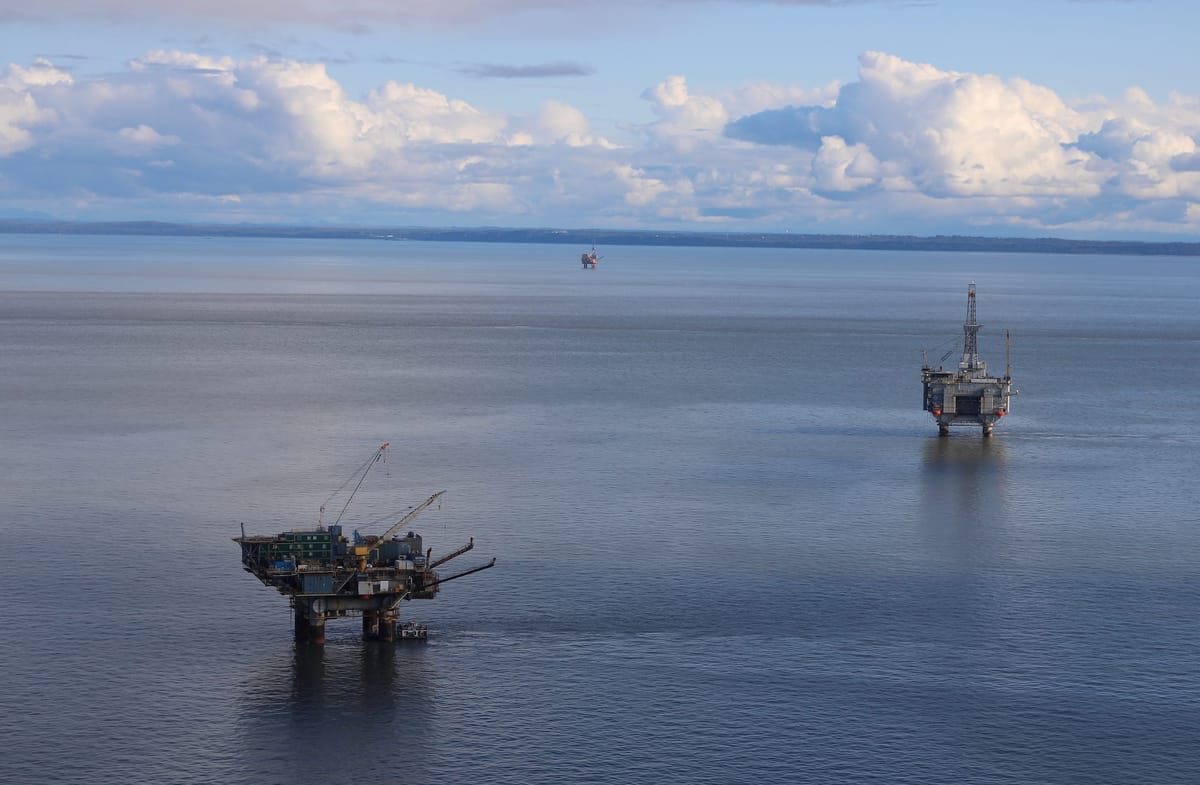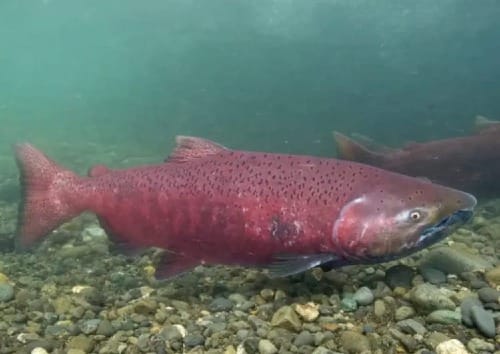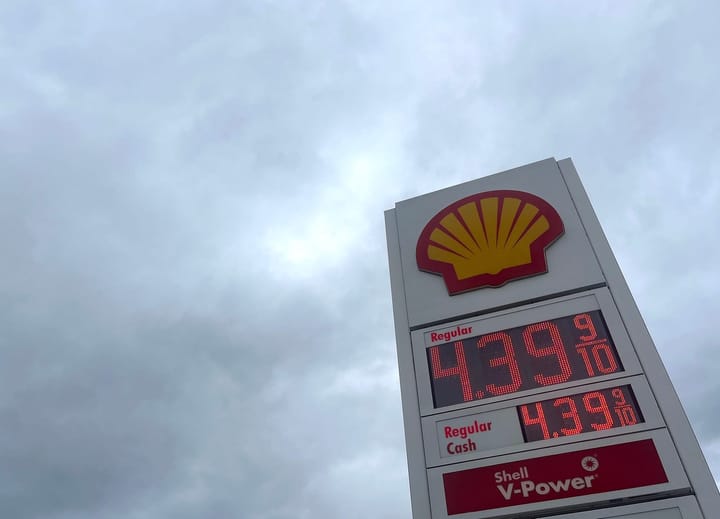Amid cold snap, equipment failure stresses Alaska's natural gas delivery system
I interviewed the president of Enstar, which runs urban Alaska's gas utility, about problems with a storage facility and how they connect to long-term energy challenges facing the region.

I make Northern Journal’s stories available, for free, to news outlets — and Alaskans — across the state. I only earn money when readers pay for a voluntary membership. If you find this information useful, please consider joining. If you’ve already signed up, thanks so much for your support. Want to advertise? Check out Northern Journal’s ad policy.
If you’re reading this, chances are good you’re inside today, because with an intense cold snap in Southcentral Alaska, it’s a little too chilly to be sitting on a park bench scrolling Northern Journal with your phone.
And if you’re inside, and you’re warm, you are almost certainly in a space that’s heated with natural gas sold by Enstar. That’s the utility that delivers the fuel to more than 150,000 customers in Anchorage, the Mat-Su and the Kenai Peninsula, and transports it for electric utilities in the region, which depend on gas to generate the vast majority of their power.
As it turns out, Enstar is seeing record demand during the cold snap — at a time when it’s also experiencing some equipment failures that stress its ability to deliver the gas needed by its customers. So far, Enstar and other utilities have been able to manage the problems without asking consumers to change their behaviors, like by lowering their thermostats. But that could change fast, and the cold weather is expected to run for at least several more days.
To hear more about this, I interviewed John Sims, Enstar’s chief executive, last night. Sims has been an increasingly vocal presence in the ongoing public discussion about Alaska’s dependence on natural gas, and how, amid decreasing production from the Cook Inlet basin near Anchorage, the state can continue to meet demand for home heating and electricity generation. Enstar, which is owned by Canadian pension funds through parent company TriSummit Utilities, is exploring the possibility of importing liquefied natural gas from outside Alaska, as well as resurrecting a dormant but pricy proposal to pipe natural gas to the Anchorage area from the North Slope.
Sims and I spoke about the specific challenges posed by the current cold snap, as well as about the big-picture questions facing policymakers. You’ll read numerous references to CINGSA; that’s Cook Inlet Natural Gas Storage Alaska, which is exactly what it sounds like — a reservoir used to hold natural gas that can be pumped out to Enstar and other users at times of peak demand. Enstar operates the facility, which is majority owned by its parent company.
You’ll also read some thought-provoking comments by Sims about the usefulness of wind and solar power in cold snaps like this one. His comments were critical, so in fairness, I asked Chris Rose, a green power advocate who heads Renewable Energy Alaska Project, for a rebuttal. His response is published at the end of the interview.
Nat Herz: I was curious if you could kind of fill me in on what you guys are dealing with?
John Sims: It was January 14, I think, we sent out what's called an OFO, an operational field order, from CINGSA to our firm and interruptible storage customers. And we had been experiencing some reduction in deliverability from one of our wells, well number three, and we started to see that it was actually producing some sand. And any time you see sand being produced, you start to wonder whether or not, is it starting to fail? What's going on down there? Because that's not normal, not something you want to see.
Nathaniel Herz: That's not what my boiler runs on.
John Sims: That's right, exactly. So we sent out that operational field order informing everyone that we were reducing the overall deliverability of the storage facility by 19%. So, normally, we have an availability of deliverability of 150 million cubic feet a day. And so by dropping it down by 19%, you know, obviously, that has an impact. Now, it wasn't that big a deal, because it was not significantly cold. But as the temperature started getting colder and colder, we started having more demand on the facility. And then ultimately, what happened was we start seeing a loss in deliverability from another well, and so we had to send out another operational field order reducing the facility's capacity by 30%. And so now, as opposed to having a maximum deliverability of 150 million cubic feet a day, now it's down to 105. And so when you start talking about 45 million cubic feet a day, now you're talking about significant and substantial deliverability that the system needs to make sure it operates during times of peak demand.
Nathaniel Herz: Gotcha. I know it's kind of hard to separate out, but it sounds like it’s fair to say that the total demand in the system right now, it's probably somewhere in the realm of maybe 300 million cubic feet a day. And CINGSA represents 150 million of that deliverability. And that's where the kind of tightness is in the system right now.
John Sims: Yeah, so, if you don't have 45 million cubic feet per day coming from things, you have to get it from someplace else. And that's where everyone is evaluating the different tools that we have in our toolbox as a system — not necessarily as Enstar, because we don't have additional contracts, for example, to pull gas from some other place. We have to rely on everyone else. So, the the possible options are, maybe Matanuska Electric Association shifts over to diesel power generation (from natural gas). We're not doing that, but that's a tool that's in the toolbox.
Nathaniel Herz: You guys haven't had to reduce delivery to your customers, it sounds like, so does that mean others are figuring out solutions at this point?
John Sims: Yeah, operationally, we're looking at a bunch of different things to make sure that we don't have to call on customers to curtail that. Do you remember the red, yellow and green chart?
When we're in condition green, everything's normal — conserve gas wisely, don't overuse. When it's yellow, that’s, ‘Hey, heads up, the system is becoming strained. We're going to look to do things like, normally we send power up the Intertie to Golden Valley Electric Association (in the Fairbanks area) — we're going to stop doing that.’ That reduces the total demand on the system. We're going to ask the military to turn down temperatures, we're going to do all these little things to help reduce demand. If we get to a point where it's red, we need everybody to turn down their thermostats, unplug unused appliances, all those kinds of things. You can actually google Washington and Oregon — they had to do this just a couple of weeks ago. Because they had a storage facility where the entire thing went down. All along the Northwest, multiple utilities were saying, ‘Hey, reduce your volume, reduce your demand.’
Nathaniel Herz: So, have you guys sent that bat signal up to the military and Golden Valley Electric Association, etc.?
John Sims: So, we haven't communicated with the military yet. But Golden Valley Electric, they are stopping economy energy sales going north.
Nathaniel Herz: Which means they're having to generate more power with more expensive generation up there, like using naphtha or coal or whatever?
John Sims: Yeah, you got it.
Nathaniel Herz: And then, I heard something about Hilcorp — they're delivering some gas from their storage, too?
John Sims: Well, they always do that. That's how they meet their contractual obligations that they have with all their customers. They produce from however many different wells that they've got in Cook Inlet, and they produce that gas and put it into storage for the winter time when we have our peak needs.
Nathaniel Herz: So, they're just meeting their contracted demand, like normal?
John Sims: They're doing the exact same things they always do. I will say, we have met with them every day. And they are saying, ‘Let us know what you need. We’re not planning on it, but we can help out,’ and all the utilities are saying the same thing. So, it's a really nice collaborative effort right now to make sure we get through this.
Nathaniel Herz: Has anyone actually had to take any significant steps beyond Golden Valley Electric Association generating more power locally at this point?
John Sims: No, not yet. We're prepared to do other things. I don't know if you've watched the temperatures, but they've gotten better over the last 24 hours than they were just a couple of days ago. When we're looking at forecasted temperatures, we're looking at Wednesday and Thursday — Thursday, being 20 below before, it's like 13 below now. Just a single degree change can make a huge difference on the overall demand on the system.
Nathaniel Herz: So, it sounds like it's fair to say that you guys are currently in a somewhat impaired situation, and the system is adapting to deal with that. And right now, it looks like it's not going to require anything dramatic, but given the the level of stress on the system, people and institutions should probably be aware that if the outlook changes or things get worse, or you get more sand in another well — that could necessitate some significant adjustments.
John Sims: Yes.
Nathaniel Herz: Do you know what's next on that list of adjustments? Is it like, ‘turn down your thermostat?’ Or are there other interstitial steps?
John Sims: Use more hydro(electric power). That's not being fully maximized at this point. Curtailing Seward, who's a wholesale customer of Chugach Electric Association, that's another piece. Golden Valley Electric can actually send power our way. Right now, today, they could probably send about 15 megawatts — they're looking to see if they could increase that even more. Matanuska Electric Association, they can generate with diesel. There are a lot of tools in the toolbox that we could take advantage of and utilize before we have to call on customers making significant adjustments and being inconvenienced.
Nathaniel Herz: Are you stressed?
John Sims: I am. Because it's interesting, Nat — you know, I'm saying this right now, but one piece of equipment failure out on a rig, and it changes on a dime. So, kind of an interesting glimpse into the utility world that nobody ever really sees or hears about. We're manned up 24 hours at CINGSA right now. That group is doing eight-hour rotations, making sure that there's somebody on site the entire time. Because if something does go wrong, yeah, we're going to have to start communicating seriously.
Nathaniel Herz: Someone pointed me to your testimony at the Regulatory Commission of Alaska earlier in the week. I listened to it, and it sounded like you had some ideas about how this cold snap ties into all of the dialogue around wind and solar right now. Can you elaborate a little bit on why that seemed relevant and worth drawing into the conversation here?
John Sims: Yeah, I get really frustrated when I hear people talking down in Juneau, to legislators in January, about how wind and solar can help alleviate the natural gas situation. It was Wednesday, I was driving in, there was fog all over the place, zero wind, zero sun, obviously. And so I made a comment, you know, ‘If anybody's telling you that wind and solar could help us out right now, in this situation, it's not true.’ I stand behind that 100%. You know, my parent company owns some wind turbines in British Columbia. It's called Bear Mountain, 102 megawatts of potential power. In the month of January, they've produced 1.8 megawatts. And it's just not a viable solution when you're looking at dealing with the kinds of challenges that we have in Alaska.
Nathaniel Herz: Are you saying that in the short term or in the long term, or both? Ie, we could use it later, but it's not here now? I was cross-country skiing just now and thinking about this, and I'm looking out at the wind turbines on Fire Island, and they're spinning. And I'm like, ‘Well, that helps, right?’
John Sims: A little bit. But is it firm?
Nathaniel Herz: I guess it's not, right?
John Sims: It goes back to, I can sign an interruptible contract tomorrow, but they can just tell me, ‘No, I'm not going to deliver it for you.’ Until we get the technology where we can harness that power and capture that power, it’s not a replacement during these high-peak times. And it's not going to be foundational, right? It’s not baseload power.
Nathaniel Herz: I mean, it could be, if we get it all integrated with batteries and other forms of storage, right?
John Sims: Absolutely. But there's a lot of information there that the general public doesn't understand. Your point is exactly spot on: With technology, with batteries, with storage, all those kinds of things, we can harness it, and leverage those and utilize that. But that's a much different cost structure and cost component than, you know, just throwing up some windmills and saying that's going to alleviate or replace natural gas.
Nathaniel Herz: Is there another policy option that you feel like legislators need to actually have in front of them right now that is a solution? Because it feels like you're saying, ‘That's not the solution — there is another solution.’
John Sims: I'd really like them to focus on base load. I mean, let's actually make some investments that, over the long term, are going to make a significant difference. And I don't feel like the small solar or wind projects make a significant enough difference. I want to make a difference. I would love to see a major hydro or geothermal — I would love to see some of those projects come on board, as an Alaskan. That's what I want to see. So, let's make some real investments in the state to change our direction and long-term plan.
Nathaniel Herz: And it sounds like at some level, your feeling is that what we're seeing right now is a sort of data point in the big picture of our natural gas picture in Southcentral Alaska — because in the past, there were more producing wells, and there was more deliverability from Cook Inlet. Is that right?
John Sims: This situation that we're talking about here — 10 years ago, we wouldn't be as stressed. Because the the line isn't as thin between really having to have customers make some immediate changes to their consumption, and just allowing additional wells to flow. We're becoming more and more reliant on storage and on CINGSA. And it's amplifying the situation that we have in Cook Inlet.
Nathaniel Herz: Can you fix the wells in CINGSA?
John Sims: Yes. Well, we're going to attempt to fix the wells. We've done this before — we've had a well sand in, we were able to go in there and fix it. There are a number of different things you can do. And this is what happens in Cook Inlet all the time. You have wells that sand in, you have wells that water up, and most of the time, you can fix them and clear them out. It's not guaranteed. But definitely most of the time.
Nathaniel Herz: How long does that take?
John Sims: It's not like it's months. It's just a matter of getting the equipment on site.
Nathaniel Herz: Probably not by next week.
John Sims: Well, actually, Hilcorp mentioned that they might be able to get something down next week. I would say in a couple of weeks, we're going to attempt to clean it out if the demand eases up a bit.
Nathaniel Herz: Because you can't necessarily get in there at the same time when it's really needed?
John Sims: Yeah. Because there's that risk of, you might damage it further. We know that we've got some deliverability coming out of it. A bird in the hand is valuable.
Nathaniel Herz: Is the high rate of production that you guys are doing from CINGSA right now, does that increase the risk that you could see problems with the other properly functioning wells?
John Sims: Yes, absolutely. Any time you're stressing the wells with high deliverability, that's when they're at the greatest risk.
Nathaniel Herz: This is why you're currently stressed. Right?
John Sims: Yeah. Because if we lose 100% of well number one, that's a problem.
In response to Sims’ comments about renewable power, I asked Chris Rose of Renewable Energy Alaska Project to weigh in. Here’s the email he sent me:
Enstar has no other business model except to sell natural gas, so it’s not that surprising that Mr. Sims would sound hostile to renewable solutions. It’s in Enstar’s interest to see the region’s electric utilities sign long-term liquefied natural gas import contracts so electric consumers can help Enstar pay for the larger and more expensive LNG import facilities that Enstar needs. However, the fact is the electric utilities have an alternative to burning gas to generate power, and they should all be pursuing cheaper wind and solar power as fast as they can.
It’s in everyone’s interest to reduce the amount of LNG the region is going to import. Alaskans are going to have a very difficult time paying for expensive and volatilely priced, imported natural gas — which all of the region’s utilities are now preparing to acquire. The region needs less dependence on expensive natural gas, not more. Electric cooperative members should urge the electric utilities to stay away from expensive, long-term LNG contracts, and move toward local, renewable solutions as rapidly as possible.
Wind and solar are the only resources that can be developed quickly enough to help the region reduce the amount of gas it needs to import in 2027, when the Department of Natural Resources projects the region will begin to run short of gas supply. The more gas we displace with wind and solar to make electricity, the more local gas the region will have for heating during cold spells like the one we’re having now.
Northern Journal is a reader-supported publication. To receive new posts and support my work, consider becoming a free or paid subscriber.



